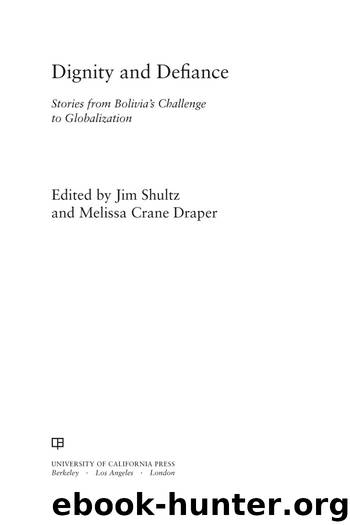Dignity and Defiance by Jim Shultz & Melissa Crane Draper

Author:Jim Shultz & Melissa Crane Draper
Language: eng
Format: epub
ISBN: 9780520942660
Publisher: University of Carolina Press
Deep Poverty and Dependence Remains
In the La Paz Children’s Hospital, Teresa, an Aymara indigenous woman, clung to her crutches as she looked anxiously at her sleeping son, Isaac. In a very soft voice, she said she was twenty, although she looked almost forty. Isaac, who was fourteen months old, had come into the hospital after being listless and weak for days. He suffered from severe malnourishment. “We didn’t have any money for food. All I could give him was breast milk,” she whispered. “But he is eating now.” She explained that she had had to borrow money just to get to the hospital, that she hadn’t eaten anything in the last two days, and that she didn’t know what she would do during the scheduled two weeks’ treatment. While her son was now eating, she was starving.69
Teresa and Isaac’s story speaks to a stark reality in Bolivia. While access to basic services such as health care have improved modestly since the HIPC debt relief initiative was launched, it has not changed Bolivia’s deep levels of impoverishment. In 2003, six years after the first HIPC initiative was launched, reports showed that poverty had increased from 63 percent to 65 percent. Extreme poverty, defined by the inability to earn enough to afford basic food, rose from 38 percent to 41 percent. That means that almost two-thirds of Bolivians live on less than ten bolivianos a day ($1.25), which is considered the minimum income required to satisfy basic needs in Bolivia. An economic recession from 2001 to 2003 amplified the problem, but even so, real per capita income in Bolivia in 2005 was lower than it was in 1978.70 With the drop in income levels, inequality has also increased. In 2001, Bolivia surpassed its neighbor Brazil for being the most economically unequal country in Latin America.71
Just as debt relief has had little impact on structural poverty, it has also done little to reduce Bolivia’s financial dependence on foreign lenders. To meet that challenge, Bolivia must develop its own sources of revenue, independent of international lenders. In Bolivia, these efforts have focused on raising taxes on the foreign oil corporations, which were given control over the country’s most valuable natural resource in the 1990s under privatization programs encouraged by the IMF and the World Bank. In response to public demands in 2005, the Bolivian Congress approved a major tax hike on the corporations. In 2006, that generated nearly a billion dollars in new revenue for Bolivia—a homegrown revenue source that overshadowed the average $81 million from debt relief. Rather than supporting these efforts, the IMF opposed these changes claiming that Bolivia failed the IMF-imposed target of creating an “appropriate framework for developing large hydrocarbons resources.”72 (For more on Bolivia’s gas and oil, see Chapter 3.)
Download
This site does not store any files on its server. We only index and link to content provided by other sites. Please contact the content providers to delete copyright contents if any and email us, we'll remove relevant links or contents immediately.
| Africa | Americas |
| Arctic & Antarctica | Asia |
| Australia & Oceania | Europe |
| Middle East | Russia |
| United States | World |
| Ancient Civilizations | Military |
| Historical Study & Educational Resources |
Cat's cradle by Kurt Vonnegut(15113)
Pimp by Iceberg Slim(14235)
4 3 2 1: A Novel by Paul Auster(12235)
Underground: A Human History of the Worlds Beneath Our Feet by Will Hunt(11986)
The Radium Girls by Kate Moore(11877)
Wiseguy by Nicholas Pileggi(5618)
Perfect Rhythm by Jae(5283)
American History Stories, Volume III (Yesterday's Classics) by Pratt Mara L(5218)
The Fire Next Time by James Baldwin(5207)
Paper Towns by Green John(5031)
Pale Blue Dot by Carl Sagan(4867)
A Higher Loyalty: Truth, Lies, and Leadership by James Comey(4803)
The Mayflower and the Pilgrims' New World by Nathaniel Philbrick(4383)
The Doomsday Machine by Daniel Ellsberg(4380)
Killers of the Flower Moon: The Osage Murders and the Birth of the FBI by David Grann(4354)
The Sympathizer by Viet Thanh Nguyen(4269)
Too Much and Not the Mood by Durga Chew-Bose(4237)
The Borden Murders by Sarah Miller(4197)
Sticky Fingers by Joe Hagan(4071)
